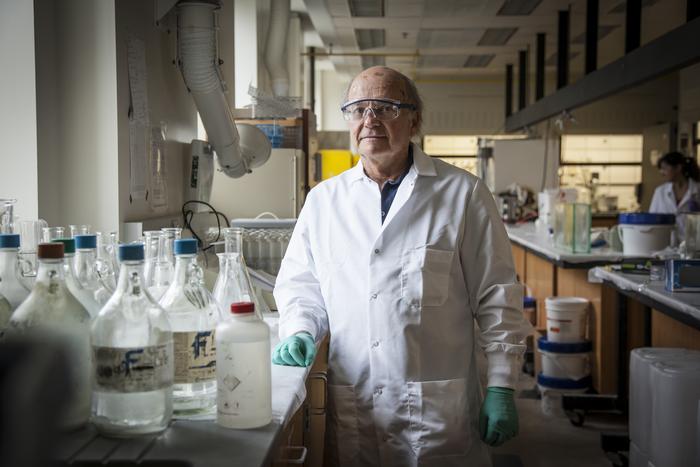DALLAS (SMU) – SMU chemistry professor John Buynak and his team have received a $3.5 million, 5-year grant from the National Institutes of Health to design and synthesize new antibiotics to fight some of the deadliest and most clinically challenging infections of the 21st century – drug resistant strains of bacteria that cause tuberculosis and leprosy.

Credit: SMU (Southern Methodist University)
DALLAS (SMU) – SMU chemistry professor John Buynak and his team have received a $3.5 million, 5-year grant from the National Institutes of Health to design and synthesize new antibiotics to fight some of the deadliest and most clinically challenging infections of the 21st century – drug resistant strains of bacteria that cause tuberculosis and leprosy.
For the past ten years, Buynak, in his lab at Southern Methodist University, has been structurally altering antibiotics, leading to new ‘atypically substituted’ drugs. These drugs are a modified version of a class of antibiotics known as carbapenem antibiotics, which weaken the cell wall of mycobacterial strains, causing bacteria to burst and die.
Initial lab testing of this atypical carbapenem is promising. It was shown to be 20-times more effective at killing mycobacterial strains than traditional carbapenems. And unlike existing carbapenems, Buynak’s modified version has improved specificity to mycobacterial infections, meaning it may be less likely to negatively affect normal bacteria and cause unnecessary side effects.
“If properly developed, these new antibiotics will provide clinicians with a fallback strategy in treatment of patients infected with highly resistant mycobacterial strains,” Buynak said.
Yet, it will take several years of further development and rigorous testing before tuberculosis patients might be able to use this modified drug.
With the NIH funding, Buynak and scientists from the University of Central Florida, U.S. Naval Academy and the University of Kentucky will see if there might be an even better version of this molecule Buynak has created. They will also see if they can turn this atypical carbapenem into a drug that can be taken orally by patients.
Could be a “magic bullet” for tuberculosis treatment
Tuberculosis (TB) is caused by a bacterium called Mycobacterium tuberculosis, and currently infects an estimated 2 billion people — one-fourth of the world’s population. Tuberculosis usually targets the lungs, but other parts of the body can be vulnerable to TB bacteria. If not treated properly, TB can be fatal.
Mycobacterium abscessus, meanwhile, is distantly related to bacteria that cause tuberculosis and leprosy and can lead to lung or skin infections. Current treatment involves giving patients combinations of powerful antibiotics over a course of months and it is often poorly tolerated by the patient, leading to a high mortality rate.
Many mycobacterial strains, like strains of other bacteria and fungi, have developed ways to defeat the drugs designed to kill them.
Drugs called beta-lactam antibiotics, including carbapenems, had been written off as a possible way to treat particularly resistant mycobacterial strains, because mycobacteria had figured out how to block these antibiotics from destroying the bacterial cell wall.
But the atypical carbapenem that Buynak created has an entirely different way to kill the cell wall – one that isn’t as affected by mycobacteria’s defense mechanism.
Atypical carbapenem is also specific to killing mycobacterial strains.
“A different target means that we can use a different ‘magic bullet’ to target them,” Buynak explained.
“By selectively inhibiting an enzyme called L,D-transpeptidase, the atypical carbapenem keeps mycobacterial strains from synthesizing a cell wall. Other, non-mycobacterial strains utilize D,D-transpeptidases in cell wall biosynthesis, and thus are not affected by the atypically modified antibiotic,” he said. “This allows the beneficial bacterial strains to survive the antibiotic, while selectively killing the mycobacterial strains.”
New antibiotics took years to develop
The extremely tough task of modifying an existing antibiotic required Buynak’s extensive knowledge of what different elements – like carbon or oxygen – would and wouldn’t do in a chemical reaction, so he could use a series of simpler chemical reactions to construct increasingly complex molecular architectures.
“We were the first to make this particular new class of beta-lactams and thus we needed to develop a new synthetic strategy to generate them,” the molecular chemist said. “It took about two years of trial and error before we succeeded.”
It also took several more years to determine that the atypical carbapenem was particularly good against Mycobacterium tuberculosis, relative to other strains.
In addition, “beta-lactam antibiotics are very sensitive to laboratory operations, and thus, the molecules had to be handled carefully.”
Four SMU graduate students seeking a PhD in biological sciences assisted Buynak with creating the new carbapenem – Pojun Quan, Noora Alkharji, Weirui Chai and Thu Nguyen. So did more than 20 SMU undergraduates.
Now, Buynak and his team need to study this atypical carbapenem, which has substantial and unusual structural alterations from the original, even more, working to optimize the many properties that are important for a successful drug candidate. Next will be several clinical trials in animals and human tissue to further test these new antibiotics.
About SMU
SMU is the nationally ranked global research university in the dynamic city of Dallas. SMU’s alumni, faculty and over 12,000 students in eight degree-granting schools demonstrate an entrepreneurial spirit as they lead change in their professions, communities and the world.




